HI EVERYBODY!!!!
Surprise! We are going to China! I am just fascinated with the mountain landscapes. I have selected some great vids and photos for this Yellow Mountain Page! I was surprised to discover from previewing the vids, that many, many people seem to go to this mountain to walk around.The stairway to Heaven is over 1500 years old. There are 60,000+ steps! Why do people want to climb to the top? I do have a friend in Canada, jerry robin, and he likes to walk around mountains, too. There must be an attraction I can not see!
I invite You to come in and get in your comfortable chair and watch these wonderful mountain video landscape tours. We can watch the others do the actual climbing!!! Enjoy-
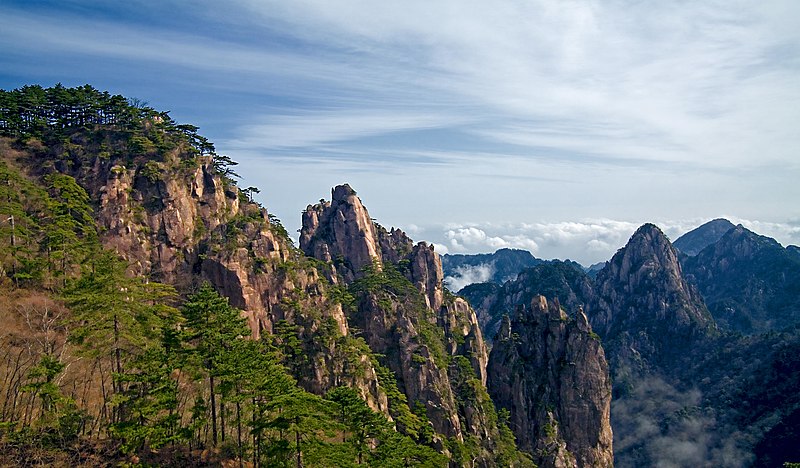
 Panoramic view of the Huangshan landscape | |
| Elevation | 1,864 m (6,115 ft)[1] |
|---|---|
| Prominence | 1,734 m (5,689 ft)[1] |
| Listing | Ultra |
Huangshan Mountains
Huangshan
From Wikipedia, the free encyclopedia
Huangshan (simplified Chinese: 黄山; traditional Chinese: 黃山; pinyin: Huángshān; literally "Yellow Mountain"[2]), is a mountain range in southern Anhui province in easternChina. The range composed of material that was uplifted from an ancient sea during theMesozoic era, 100 million years ago. The mountains themselves were carved by glaciers during the Quaternary. Vegetation on the range is thickest below 1,100 meters (3,600 ft), with trees growing up to the treeline at 1,800 meters (5,900 ft).
The area is well known for its scenery, sunsets, peculiarly shaped granite peaks,Huangshan Pine trees, and views of the clouds from above. Huangshan is a frequent subject of traditional Chinese paintings and literature, as well as modernphotography. It is a UNESCO World Heritage Site, and one of China's major tourist destinations
| Location | |
|---|---|
| Location in China | |
| Location | Anhui |
| Coordinates | 30°07′30″N 118°10′00″ECoordinates: 30°07′30″N 118°10′00″E[1] |
Just Push Play>

Physical description
Huangshan is known for its sunrises,[3] pine trees,[4] "strangely jutting granite peaks",[5] and views of clouds touching the mountainsides for more than 200 days out of the year.[2][4][5][6]
The Huangshan mountain range has many peaks, some more than 1,000 meters (3,250 feet) high.[7] The three tallest and best-known peaks are Lotus Peak (Lian Hua Feng, 1,864 m), Bright Summit Peak (Guang Ming Ding, 1,840 m), andCelestial Peak (Tian Du Feng, literally Capital of Heaven Peak, 1,829 m).[2][5] The World Heritage Site covers a core area of 154 square kilometres and a buffer zone of 142 square kilometres.[8] The mountains were formed in the Mesozoic, about 100 million years ago, when an ancient sea disappeared due to uplift.[9] Later, in theQuaternary Period, the landscape was shaped by the influence of glaciers.[9]
The vegetation of the area varies with altitude. Mesic forests cover the landscape below 1,100 meters. Deciduous forest stretches from 1,100 meters up to the tree line at 1,800 meters. Above that point, the vegetation consists of alpine grasslands. The area has diverse flora, where one-third of China's bryophyte families and more than half of its fern families are represented. The Huangshan pine (Pinus hwangshanensis) is named after Huangshan and is considered an example of vigor because the trees thrive by growing straight out of the rocks.[9] Many of the area's pine trees are more than a hundred years old and have been given their own names (such as the Ying Ke Pine, orWelcoming-Guests Pine, which is thought to be over 1500 years old).[5] The pines vary greatly in shape and size, with the most crooked of the trees being considered the most attractive.[6] Furthermore, Huangshan's moist climate facilitates the growing of tea leaves,[10] and the mountain has been called "one of China's premier green tea-growing mountains.[11] Mao feng cha ("Fur Peak Tea"), a well-known local variety of green tea,[12] takes its name from the downy tips of tea leaves found in the Huangshan area.[13]
The mountaintops often offer views of the clouds from above, known as the Sea of Clouds (Chinese: 云海; pinyin: yúnhǎi)[10] or "Huangshan Sea"[6] because of the cloud's resemblance to an ocean, and many vistas are known by names such as "North Sea" or "South Sea."[6] One writer remarked on the view of the clouds from Huangshan as follows:
To enjoy the magnificence of a mountain, you have to look upwards in most cases. To enjoy Mount Huangshan, however, you've got to look downward.[6]
The area is also host to notable light effects, such as the renowned sunrises. Watching the sunrise is considered a "mandatory" part of visiting the area.[3] A phenomenon known as Buddha's Light (Chinese: 佛光; pinyin: fóguāng)[14] is also well-known and, on average, Buddha's Light only appears a couple times per month.[15] In addition, Huangshan has multiple hot springs, most of them located at the foot of the Purple Cloud Peak. The water stays at 42 °C all year[16] and has a high concentration of carbonates, and is said to help prevent skin, joint, and nerve illness
Walking On Air on Yellow Mountain!
Just Push Play>

History
Huangshan was formed approximately 100 million years ago and gained its unique rock formations in the Quaternary Glaciation.[9]
During the Qin Dynasty, Huangshan was known as Yishan (Mount Yi). In 747 AD, its name was changed to Huangshan (Mount Huang) by imperial decree;[17] the name is commonly thought to have been coined in honor of Huang Di (the Yellow Emperor), a legendary Chinese emperor and the mythological ancestor of the Han Chinese.[18] One legend states that Huangshan was the location from which the Yellow Emperor ascended to Heaven.[5] Another legend states that the Yellow Emperor "cultivated moral character and refined pills of immortality in the mountains, and in so doing gave the mountains his name.[9] The first use of this name "Huangshan" is often attributed to Chinese poet Li Bai.[18] Huangshan was fairly inaccessible and little-known in ancient times, but its change of name in 747 AD seems to have brought the area more attention; from then on, the area was visited frequently and many temples were built there.[17]
Huangshan is known for its stone steps,[5] carved into the side of the mountain, of which there may be more than 60,000 throughout the area.[3][19][20] The date at which work on the steps began is unknown, but they have been said to be over 1,500 years old.[19]
Over the years, many scenic spots and physical features on the mountain have been named;[6] many of the names have narratives behind them. For example, one legend tells of a man who did not believe the tales of Huangshan's beauty and went to the mountains to see for himself; he was almost immediately convinced. One of the peaks he supposedly visited was named Shixin (视信), roughly meaning "believing after seeing."[6]
In 1982, Huangshan was declared a "site of scenic beauty and historic interest" by the State Council of the People's Republic of China.[17] It was named a UNESCO World Heritage Site in 1990 for its scenery and for its role as a habitat for rare and threatened species.[4]
In 2002, Huangshan was named the "sister mountain" of Jungfrau in the Swiss Alps
OMG-You are not going to believe this: (2 min)Cliffside Walk---Just Push Play>
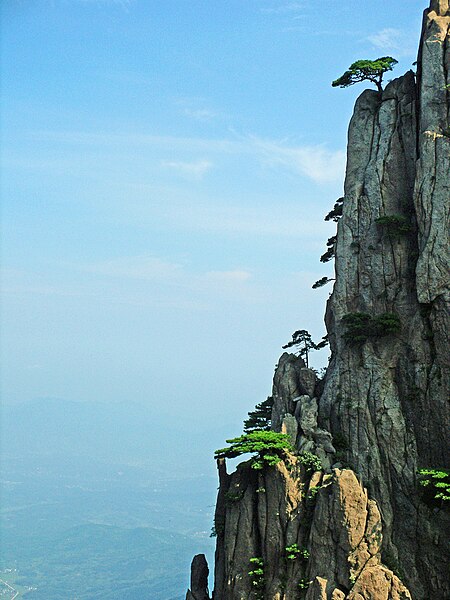
The complete PLANK WALK! (10 min)
Just Push Play>
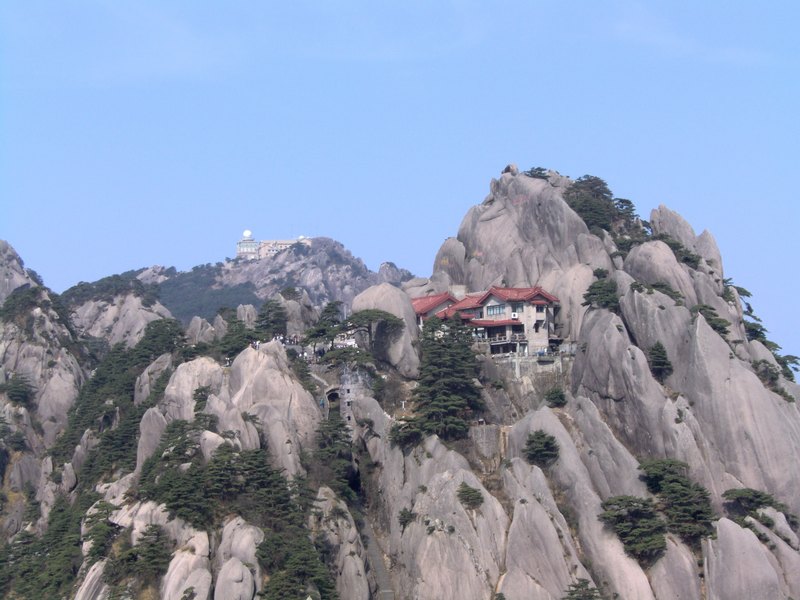
Artistic and scientific inspirations
Much of Huangshan's reputation derives from its significance in Chinese art and literature.[21]In addition to inspiring poets such as Li Bai,[3][8] Huangshan and the scenery therein has been the frequent subject of poetry and artwork, especially Chinese ink painting[17] and, more recently, photography.[2] Overall, from the Tang Dynasty to the end of the Qing Dynasty, over 20,000 poems were written about Huangshan, and a school of painting named after it.[5][6]The mountains have also appeared in modern works. James Cameron, director of the 2009 film Avatar, cited Huangshan as one of his influences in designing the fictional world of that film.[22]
The area has also been a location for scientific research because of its diversity of flora and wildlife. In the early part of the 20th century, the geology and vegetation of Huangshan were the subject of multiple studies by both Chinese and foreign scientists.[17] The mountain is still a subject of research. For example, in the late 20th century a team of researchers used the area for a field study of Tibetan Macaques, a local species of monkey.

China Revealed (1 min) Great
Just Push Play>

Tourism
Having at least 140 sections open to visitors,[4] Huangshan is a major tourist destination in China.[2][3] In 2007, for instance, over 15 million tourists visited the mountain.[24] The foot of the mountains is linked by rail and by air to Shanghai,[2] and is also accessible from cities such as Hangzhou and Wuhu.[25] As of 1990, there were over 50 kilometers of footpaths providing access to scenic areas for visitors and staffers of the facilities.[17] Today there are also cable cars that tourists can use to ride directly from the base to one of the summits.[2]Throughout the area there are hotels and guest houses that accommodate overnight visitors,[2][17] many of whom hike up the mountains, spend the night at one of the peaks to view the sunrise, and then descend by a different route the next day.[3] The area is classified as a AAAAA scenic area by the China National Tourism Administration.[26]
The hotels, restaurants, and other facilities at the top of the mountain are serviced and kept stocked by porters who carry resources up the mountain on foot, hanging their cargo from long poles balanced over their shoulders or backs.
A Masterpiece of Music and Mountain Images
(4 min) Just Push Play>

Magical Sunset Tour of Yellow Mountain
Just Push Play>

Another Magnificent Composition,
The Essence of Creativity
5 great minutes-Just Push Play>

The Mountains in the Snow (5 min)
Great Music and Images-Just Push Play>
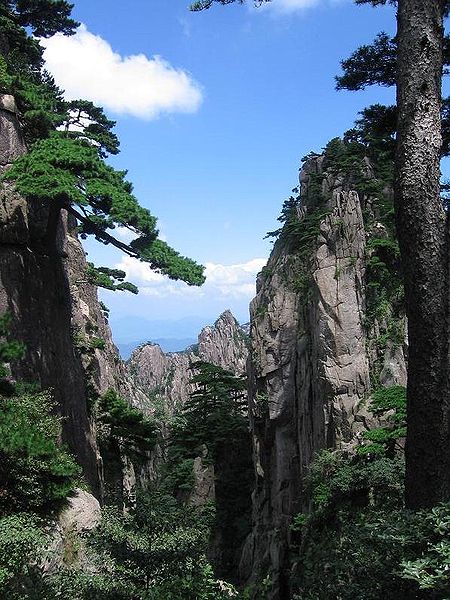
Yet Another Fantastic Video Tour (7 min)
Just Push Play>

......this is brendasue falling off the mountain!!!!
See You next time.
Of course, one more Great Performance
Just Push Play>
Uploaded by ezbf95ez on Mar 10, 2010
China's many mountains, including the famous Huangshan mountain, Huangshan in Anhui, Jiangxi Lushan the chronicle Qixiu heaven known fame .Five Sacred Mountains: The Five Sacred Mountains is the general term of the Taoist worship of China's five famous mountains every mountain has Yue God, East Yuetai mountain of God King of Qi, the Hengshan Secretary King, Huashan Mountain Gold King, the Hengshan An kings. in Songshan King leading the the Asgard Lady tens of thousands of people to govern their four famous Buddhist mountains: According to legend, Wutai Mountain in Shanxi was the Manjusri temple Sichuan Emei is Samantabhadra temples, Putuo Mountain in Zhejiang was the temple of the Goddess of Mercy,安徽九华山is the temple of Jizo . four famous Taoist: Taoist originated from the Lung Fu Shan in Jiangxi Province, the legendary first generation Heavenly Master Zhang Ling, Lian nine to Shendan this enlightenment after Shu and his grandson Zhang Lu in Prachuab pass their Road when Taoism Ten Cave, 72 blessed are the Taoist famous of which is particularly famous Wudang Mountain in Hubei, Jiangxi Lung Fu Shan, Anhui Qiyunshan, Sichuan Qingcheng Mountain. Nine mountain was listed by UNESCO into the honor of the World Cultural and Natural Heritage (UNESCO) approved.
中國的名山眾多, 其中以黃山歸來不看岳聞名的安徽黃山, 匡廬奇秀甲天下著稱的江西廬山的名氣最大. 有五嶽: 五嶽是道教崇奉的中國五大名山的總稱. 每岳都有岳神, 東岳泰山岳神齊天王, 南嶽衡山司天王, 西嶽華山金天王, 北岳恆山安天王. 中嶽嵩山中天王. 各領仙宮玉女幾萬人治理其地. 有四大佛教名山: 相傳山西五台山曾是文殊菩薩的道場, 四川峨眉山曾是普賢菩薩的道場, 浙江普陀山曾是觀音菩薩的道場, 安徽九華山曾是地藏菩薩的道場. 有四大道教名山: 道教發祥於江西省的龍虎山, 傳說第一代天師張道陵, 煉九轉神丹於此. 得道後入蜀,其孫張魯在巴蜀傳其道. 當時道教有十大洞天, 七十二福地, 均為道教名山. 其中是湖北武當山, 江西龍虎山, 安徽齊雲山, 四川青城山尤為著名。
O+O
*Note:
All above videos are from You Tube. When I am creating this Blog, there is an option to add the videos from You Tube. You Tube has added a new feature to my selected videos on each page. At the end of most of the videos, 4 more options appear. These are 'live' and can be watched here on the Blog! I have not seen all of them, but they seem to be on the same subject as the video they are attached to. I just wanted to share this information with You in case You want to view more. You could stay here in the Blog for Days!!!!!!!!!!
*Note2:
All of the above information and photos are from Wikipedia (with permission). This site not only has great information, but also encourages the sharing of knowledge.
File history
Click on a date/time to view the file as it appeared at that time.
| Date/Time | Thumbnail | Dimensions | User | Comment | |
|---|---|---|---|---|---|
| current | 08:16, 22 September 2010 |  | 1,700 × 1,200(258 KB) | Blbrk | {{Information |Description={{en|1=Stairway for tourists built on the cliffs of Yellow Mountain}} |Source={{own}} |Author=Blbrk |Date= |Permission= |other_versions= }}Category:Huangshan |
File usage
The following pages on the English Wikipedia link to this file (pages on other projects are not listed):




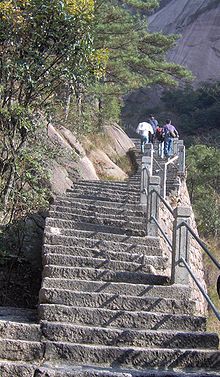


No comments:
Post a Comment
Hi Everybody! Please say hello and follow so I know you are here! Due to the inconsideration of people trying to put commercials on my blog comment area, I have restricted use of anonymous posts. Sorry that some hurt all.
My public email is katescabin@gmail.com No spammers or trolls